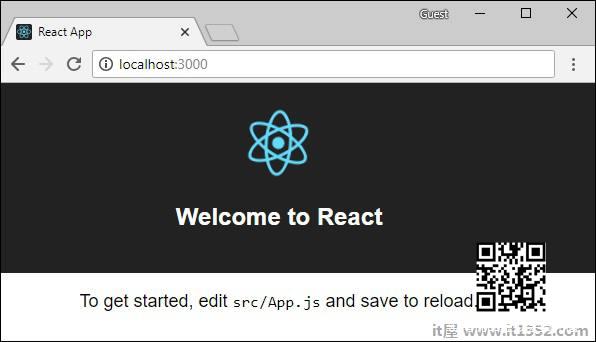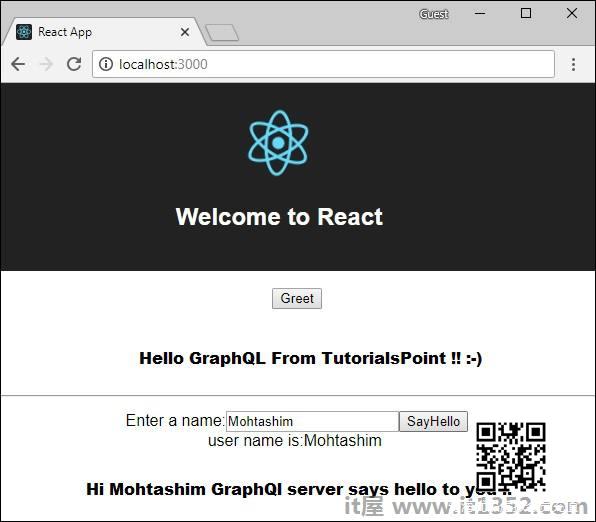React是一个用于构建用户界面的Javascript库.本章解释了如何将GraphQL与React应用程序集成.
插图
设置反应项目的最快方法是使用创建React App 工具.在随后的部分中,我们将学习如何设置服务器和客户端.
设置服务器
用于设置服务器,按照以下步骤 : 去;
步骤1 : 号;下载并安装项目所需的依赖项
创建文件夹 react-server-app .从终端将目录更改为 react-server-app .按照环境设置章节中说明的步骤3到5进行操作.
步骤2 : 创建模式
在项目文件夹 react-server-app 中添加 schema.graphql 文件并添加以下代码 :
type Query{ greeting: String sayHello(name:String!):String}该文件定义了两个查询 - greeting和sayHello. sayHello查询接受字符串参数并返回另一个字符串. sayHello()函数的参数不为空.
步骤3 : 创建解析器
在项目文件夹中创建文件 resolvers.js 并添加以下代码 :
const Query ={ greeting: () => 'Hello GraphQL From TutorialsPoint !!' , sayHello:(root,args,context,info) => `Hi ${args.name} GraphQL server says Hello to you!!`}module.exports = {Query}这里问候和说你好是两个解决方案.在sayHello解析器中,可以通过args访问传递给name参数的值.要访问模块外部的解析器函数,必须使用module.exports导出Query对象.
步骤4 : 运行应用程序
创建server.js文件.请参阅环境设置章节中的步骤8.在终端中执行命令 npm start .服务器将在9000端口上启动并运行.在这里,我们使用GraphiQL作为客户端来测试应用程序.
打开浏览器并输入URL http://localhost:9000/graphiql .在编辑器中输入以下查询 :
{ greeting, sayHello(name:"Mohtashim")}来自服务器的响应低于 :
{ "data": { "greeting": "Hello GraphQL From TutorialsPoint !!", "sayHello": "Hi Mohtashim GraphQL server says Hello to you!!" }}设置客户端
为客户端打开一个新终端.在执行客户端应用程序之前,服务器终端应保持运行. React应用程序将在端口号3000上运行,服务器应用程序在端口号9000上运行.
步骤1和减号;创建React项目hello-world-client
在客户端终端中,键入以下命令 :
npx create-react-app hello-world-client
这将安装典型反应应用程序所需的一切. npx 实用程序和 create-react-app 工具创建一个名为hello-world-client的项目.安装完成后,在VSCode中打开项目.
步骤2 : 启动hello-world-client
将终端中的当前文件夹路径更改为hello-world-client.键入npm start以启动项目.这将在端口3000运行开发服务器,并将自动打开浏览器并加载索引页.
这在下面给出的屏幕截图中显示 :

步骤3 : 去;修改应用程序组件
在src文件夹内的App.js中,添加两个函数,一个用于加载问候语,另一个用于加载sayHello消息.
以下是loadGreeting函数,它发送用于问候语的GraphQL查询.
异步函数loadGreeting(){ const response = await fetch(' http://localhost:9000/graphql',{方法:'POST', header:{'content-type':'application/json'}, body:JSON.stringify({query:'{greeting}'})}) const rsponseBody = await response.json(); 返回rsponseBody.data.greeting; console.log("函数结束")}以下是 loadSayhello 为sayHello : 发送GraphQL查询的函数;
async function loadSayhello(name) { const response = await fetch('http://localhost:9000/graphql', { method:'POST', headers:{'content-type':'application/json'}, body:JSON.stringify({query:`{sayHello(name:"${name}")}`}) })}完整的 App.js 文件显示在下方 :
import React, { Component } from 'react';import logo from './logo.svg';import './App.css';async function loadGreeting() { const response = await fetch('http://localhost:9000/graphql', { method:'POST', headers:{'content-type':'application/json'}, body:JSON.stringify({query:'{greeting}'}) }) const rsponseBody = await response.json(); return rsponseBody.data.greeting; console.log("end of function")}async function loadSayhello(name) { const response = await fetch('http://localhost:9000/graphql', { method:'POST', headers:{'content-type':'application/json'}, body:JSON.stringify({query:`{sayHello(name:"${name}")}`}) }) const rsponseBody = await response.json(); return rsponseBody.data.sayHello;}class App extends Component { constructor(props) { super(props); this.state = {greetingMessage:'',sayHelloMessage:'',userName:''} this.updateName = this.updateName.bind(this); this.showSayHelloMessage = this.showSayHelloMessage.bind(this); this.showGreeting = this.showGreeting.bind(this); } showGreeting() { loadGreeting().then(g => this.setState({greetingMessage:g+" :-)"})) } showSayHelloMessage() { const name = this.state.userName; console.log(name) loadSayhello(name).then(m => this.setState({sayHelloMessage:m})) } updateName(event) { this.setState({userName:event.target.value}) } render() { return ( Welcome to React
Greet
{this.state.greetingMessage}
